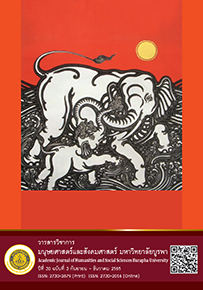Investigating Consumers’ Apparel Retail Format Choice: The Roles of Decision-making Styles and Retail Attributes
Main Article Content
Abstract
With the increase in competitive markets and the evolution of new channels (e.g., internet, mobile), the ability to identify, and understand consumers’ preferences may very well define retail success. The current study explores how consumers’ decision-making styles influence their evaluation of retail attributes, which in turn, affect their retail format choices (i.e., upscale department stores vs. off-price retailers) in the apparel shopping context. A convenience sample of 344 undergraduate students were collected and tested
using a structural equation analysis. Results revealed that perfectionist dimension of consumers’ decision-making styles positively influenced the evaluation of service-related retail attributes, which positively influenced their selection of upscale department stores. Furthermore, fashion consciousness, perfectionist, and brand loyalty dimensions of consumers’ decision-making styles positively influenced their evaluation of shopping incentive-related retail attributes, which positively influenced their choice to patronize off-price retailers and negatively influenced their choice of upscale retailers. Implications and future research directions are suggested.
Downloads
Article Details

This work is licensed under a Creative Commons Attribution-NonCommercial-NoDerivatives 4.0 International License.
บทความทุกบทความเป็นลิขสิทธิ์ของวารสารวิชาการมนุษยศาสตร์และสังคมศาสตร์ มหาวิทยาลัยบูรพาเท่านั้น
References
Anderson, J. C., & Gerbing, D. W. (1988). Structural equation modeling in practice: A review and recommended two-step approach. Psychological Bulletin, 103(3), 411-423.
Arnold, S. J., Ma, S., & Tigert, D. J. (1978). A comparative analysis of determinant attributes in retail store selection. Advances in Consumer Research, 5, 663-667.
Bagozzi, R. P., Yi, Y., & Phillips, L. W. (1991). Assessing construct validity in organizational research. Administrative Science Quarterly, 36(3), 421-458.
Baker, J., Parasuraman, A., Grewal, D., & Voss, G. B. (2002). The influence of multiple store environment cues on perceived merchandise value and patronage intentions. Journal of Marketing, 66(2), 120-141.
Bakewell, C., & Mitchell, V. W. (2003). Generation Y female consumer decision-making styles. International Journal of Retailing & Distribution Management, 31(2), 95-106.
Bauer, H. H., Sauer, N. E., & Becker, C. (2006). Investigating the relationship between product involvement and consumer decision-making styles. Journal of Consumer Behavior, 5(4), 342-354.
Bearden, W. O. (1977). Determinant attributes of store patronage: Downtown versus outlying shopping centers. Journal of Retailing, 53(2), 15-22.
Carpenter, J. M., & Moore, M. (2006). Consumer demographics, store attributes, and retail format choice in the U.S. grocery market. International Journal of Retail & Distribution Management, 34(6), 434-452.
Carpenter, J. M., & Balija, V. (2010). Retail format choice in the US consumer electronics market. International Journal of Retail Distribution Management, 38(4), 258-274.
Choi, S. (2000). Exploration of retail patronage: Developing a discount store patronage model. [Doctoral dissertation, Purdue University]. http://www.docs.lib.purdue.edu
Diep, V. C. S., & Sweeney, J. C. (2008). Shopping trip value: Do stores and products matter?. Journal of Retailing and Consumer Services, 15(5), 399-409.
Donovan, R. J., Rossiter, J. R., Marcoolyn, G., & Nesdale, A. (1994). Store atmosphere and purchasing behavior. Journal of Retailing, 70(3), 283-294.
Enis, B. M., Cox, K. K., & Stafford, J. (1972). Students as subjects in consumer behavior experiments. Journal of Marketing Research, 9(1), 72-74.
Finn, A., & Louviere, J. J. (1996). Shopping center image, consideration, and choice: Anchor store contribution. Journal of Business Research, 35(3), 241-251.
Fornell, C., & Larcker, D. F. (1981). Structural equation models with unobservable variables and measurement error: Algebra and Statistics. Journal of Marketing Research, 18(1), 382-388.
Jamal, A., & Goode, M. (2001). Consumers' product evaluation: A study of the primary evaluative criteria in the precious jewellery market in the UK. Journal of Consumer Behaviour, 1(2), 140-155.
Joreskog, K. G., & Sorbom, D. (1993). LISREL8: Structural equation modeling with the SIMPLIS command language. Erlbaum.
Kaiser, S. B. (1998). The social psychology of clothing: Symbolic appearances in context. Macmillan.
Nunnally, J. C., & Bernstein, I. H. (1994). Psychometric theory (3rd ed.). McGraw-Hill.
Miller, C. E., Reardon, J., & McCorkle, D. E. (1999). The effects of competition on retail structure: An examination of intratype, intertype, and intercategory competition. Journal of Marketing, 63(4), 107-120.
Oliver, R. L. (1997). Satisfaction: A behavioral perspective on the consumer. McGraw-Hill.
Oh, J., & Fiorito, S. S. (2002). Korean women’s clothing brand loyalty. Journal of Fashion Marketing and Management, 6(3), 206-222.
Olsen, S. O., & Skallerud, K. (2011). Retail attributes’ differential effects on utilitarian versus hedonic shopping value. Journal of Consumer Marketing, 28(7), 532-539.
Pan, Y., & Zinkhan, G. M. (2006). Determinants of retail patronage: A metaanalytical perspective. Journal of Retailing, 82(3), 229-243.
Seiders, K., Simonides, C., & Tigert, D. J. (2000). The impact of supercenters on traditional food retailers in four markets. International Journal of Retail & Distribution Management, 28(4/5), 181-193.
Sproles, G. B., & Kendall, E. L. (1986). A methodology for profiling consumers’ decision-making styles. Journal of Consumer Affairs, 20(2), 267-279.
Tan, J. P. T., & Freathy, P. (2011). Consumer decision making and store patronage behaviour in traditional Chinese medicine (TCM) halls in Singapore. Journal of Retailing and Consumer Services, 18(4), 285-292.
Vazquez, R., Rodriguez-Del Bosque, I. A., Diaz, A. M., & Ruiz, A. V. (2001). Service quality in supermarket retailing: Identifying critical service experiences. Journal of Retailing and Consumer Services, 8, 1-14.
Wolburg, J. M., & Pokrywczynski, J. (2001). A psychographic analysis of Generation Y college students. Journal of Advertising Research, 41(5), 33-52.
Yan, R-N., & Eckman, M. (2009). Are lifestyle centre unique? Consumers' perceptions across locations. International Journal of Retail & Distribution Management, 37(1), 24-42.


